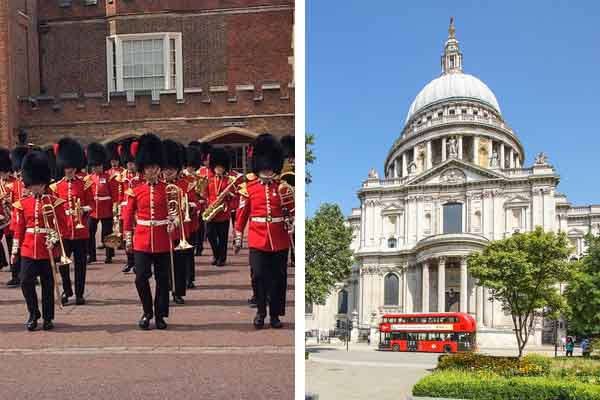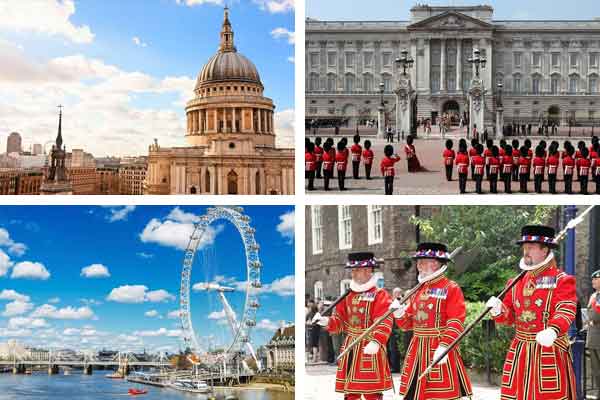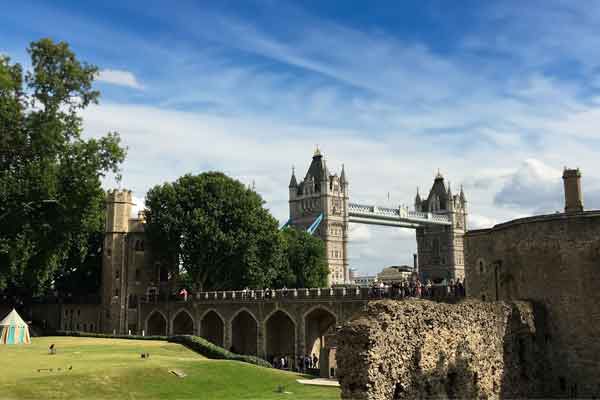St. Paul's Cathedral
A Comprehensive Guide to Tickets, Tours, and Historical Insights
Uncovering the Past: A Deep Dive into the History of St. Paul’s Cathedral
Stepping into St. Paul’s Cathedral not only allows visitors to explore a stunning architectural wonder but also to journey through the vivid tapestry of its centuries-old history.
Whenever I meander through the bustling streets of London, there’s one silhouette that always captures my heart – the magnificent dome of St. Paul’s Cathedral. It’s not just an architectural marvel; it’s a symbol of London’s resilience and spirit. For those stepping into this city for the first time, or the hundredth, St. Paul’s calls out like an old friend, its rich history and breathtaking beauty a testament to the city’s past and present.
Visiting St. Paul's Cathedral: Practical Information for Visitors
Tube / Metro
Address: St Paul’s Churchyard, London, EC4M 8AD.
Nearest Underground Station: 3-minute walk from St Paul’s Underground Station in Zone 1, served by Central line (red).
Opening Times
Sightseers are welcome from Monday to Saturday. Doors open at 8.30am on most weekdays and 10am on Wednesdays. As a working church, Sundays are for worship only. Last admission is usually at 4pm.
Time Needed to Visit
On average, visitors typically spend around 1.5 to 2 hours exploring the cathedral, including admiring the architecture, viewing the interior, visiting the crypt, and climbing the dome for panoramic views of the city.
Accessibility
The cathedral is committed to ensuring all visitors, regardless of ability, can explore its grandeur. Special guides, tours, and accessibility measures are in place. For detailed information, the Accessibility page on the cathedral’s website is incredibly helpful.
Why Visit St. Paul's Cathedral?
Now, why should you consider St. Paul’s Cathedral a must-visit on your London itinerary?
Each visit feels like the first—such is the allure of this iconic institution.
- Experience the soul of London: Picture this, you’re standing in the heart of London, surrounded by the hustle and bustle of city life, and then you step into the tranquil grandeur of St. Paul’s Cathedral. Instantly, you’re transported to a place where history, art, and spirituality converge in the most breathtaking manner.
- Architecture: Firstly, St. Paul’s is not just an architectural masterpiece; it’s a symbol of resilience and hope. Having survived the Blitz of World War II, it stands as a testament to the enduring spirit of London. I remember standing beneath its magnificent dome, looking up, and feeling an overwhelming sense of awe. The beauty of Sir Christopher Wren’s design, with its intricate details and imposing structure, is something that pictures simply don’t do justice to.
- History: Then there’s the history. St. Paul’s has been the site of momentous events, including the funerals of Lord Nelson and Winston Churchill, and the jubilant wedding of Prince Charles and Lady Diana. Each corner of this cathedral has a story to tell, from the Whispering Gallery, where your whispers can be heard clearly on the opposite side, to the Golden Gallery, offering panoramic views of London that are truly unmatched.
- Serenity: But it’s not just about what you see; it’s about what you feel. There’s a certain serenity here, a quiet majesty that invites reflection. Whether you’re attending a service, enjoying the choir, or simply sitting in quiet contemplation, St. Paul’s offers a spiritual experience that’s both uplifting and grounding.
- Art & Memorials: And let’s not forget the art and memorials. The cathedral houses some of the most exquisite mosaics, paintings, and sculptures, telling the Christian story and commemorating heroes of the British Empire. It’s a place where art and history enthusiasts can feast their eyes and souls on the beauty and depth of each piece.
Opening Times
St Paul’s Cathedral sightseeing opening hours are:
- Mon-Tue & Thu-Sat: 8.30am – 4.30pm
- Wed: 10am – 4:30pm
- Last sightseeing entry 4pm.
Sundays are for worshipping only. Timings can vary, so it’s wise to check the cathedral’s calendar for the specific day of your visit.
Special Tip for Visitors Over 35
If you’re seeking a deeper understanding and appreciation of St. Paul’s art and history, consider visiting during quieter times, typically weekday mornings. This allows for a more contemplative experience. Additionally, look out for special events or exhibitions that often provide a unique glimpse into the cathedral’s rich tapestry of stories.
Where is St Paul's Cathedral? How to Get There
St. Paul’s Cathedral sits proudly at St Paul’s Churchyard, London, EC4M 8AD. The cathedral is centrally located in London. It’s a stone’s throw away from several transport links, making it easily accessible from major train stations and other parts of the city.
By London Underground (Tube / Metro / Subway)
Nearest Station: St. Paul’s Underground Station, served by Central line, a 5-min walk to the cathedral.
![]()
Closest Stations: City Thameslink (5-min walk) and Blackfriars (8-min walk), ensuring easy access for all.
Several bus routes can get you to St. Paul’s Cathedral including 4, 8, 15, 17, 23, 25, 26, 56, 76, 100, 172, 242 and 521.
Most hop-on hop-off sightseeing buses stop outside the cathedral, making it convenient for travellers exploring London.
Uber Boat by Thames Clippers frequently stop at Blackfriars Pier (10-min walk approx.) and Bankside Pier (15-min walk approx.)
We recommend avoiding driving due to unpredictable London traffic, scarce and costly parking, and St. Paul’s Cathedral being within the Congestion Charge Zone without parking facilities. However, if necessary, here are the closest parking options:
While on-street parking is limited, the Baynard House car park on Queen Victoria Street is the nearest public car park, just a 6-minute walk away.
Disabled blue badge holders can find parking bays near the cathedral using the interactive map provided by the City of London.
You can find complimentary bicycle parking in designated racks along various streets surrounding the Cathedral.
Nearest Santander Cycles docking stations are at Newgate Street and Queen Victoria Street.
Walking to St. Paul’s Cathedral offers a delightful experience, allowing you to soak in the rich history and architectural beauty of London along the way. Utilise TFL’s Route Planner to discover walking paths and estimated travel times from your starting location.
St Paul’s Cathedral Ticket Types and Prices
While entrance for worship is free, sightseeing requires a ticket. Adults pay £25, and there’s a £10 charge for children (6-17), with discounts available for seniors (65+), students (18+), families and groups (15 visitors or more). Infants (0-5), disabled visitors and their carer / companions go free.
How to Book, Prices and Discounts
You can secure your sightseeing tickets either online, ensuring availability on the date and time of your choice and flexibility in planning your visit, or in person.
Standard Ticket Prices
- Adult (18-64) £25
- Senior (65+) £22.50
- Student (18+) £22.50
- Child (6-17) £10
Family Ticket Prices
- 1 adult + 2 children (6-17) £35
- 2 adults + 2 children (6-17) £60
- 2 adults + 3 children (6-17) £60
Group Ticket Prices
Group ticket bookings are available for parties of 15 or more, with a maximum of 60 group tickets per transaction. Find out more.
- Adult (18-64) £22.50
- Senior (65+) £20
- Student (18+) £20
- Child (6-17) £9
Occasionally, free tickets are up for grabs. For the most current information, visit the official ticket page.
St Paul's Cathedral Tours
Tour Options offered by St Paul's Cathedral
Self-Guided Multimedia Tours
Guided Group Tours - Free for Ticket Holders
Join a knowledgeable guide for a more structured exploration of St. Paul’s, complimentary for ticket holders. It’s a great way to learn about the cathedral’s nuances and hidden stories.
- Highlights Tour offers a condensed 20-30 minute exploration.
- Cathedral Floor and Crypt Tour provides a comprehensive 60-90 minute journey.
- Touch Tours offer a tactile exploration for visually impaired visitors, lasting 2 hours.
Conducted in English, these tours run Monday to Saturday at various times, typically between 11am and 3pm and can be booked on the day of visit, subject to availability – simply inquire at the Guiding Desk.
Cathedral Floor and Crypt Tour for Private Groups - From £125
Embark on a private Cathedral Floor and Crypt tour at St. Paul’s Cathedral for £125 accommodating up to 10 people, with an additional £12.50 per person thereafter. The tour lasts 60 minutes and is available from Monday to Saturday at 11:15am, 1:15pm, or 2:15pm.
To book, email admissions@stpaulscathedral.org.uk or call +442072468357 at least one month in advance.
Larger groups of up to 50 visitors can be accommodated, with multiple guides provided for a more personalised experience.
Triforium Tour - £15pp or £300 for Groups of max. 20
Experience the Triforium tour at St. Paul’s Cathedral, delving into its hidden treasures and offering breathtaking views from iconic vantage points. Ideal for returning visitors seeking a deeper exploration, this tour includes visits to the library, Trophy Room, and Great Model, providing behind-the-scenes insights into the cathedral’s history.
- For individuals, tickets are priced at £15 per person, available to purchase on the day of visit.
- Private group tours cost £300 for up to 20 people and must be booked at least one month in advance (email admissions@stpaulscathedral.org.uk or call +442072468357 ), offering exclusive access to this unique experience.
Accessibility: Due to numerous stairs involved, it’s not suitable for wheelchair users or those with mobility issues, and seating is unavailable throughout.
Please note: Photography is permitted for personal use, but videography is not allowed.
London Group Tours Visiting St Paul's Cathedral
Explore the rich history and architectural marvels of St. Paul’s Cathedral in London tours that include a visit to the cathedral alongside other iconic attractions, offering a convenient and enriching way to explore the best of London in a single day.
Walking Tour
Tour Guide
Small Group
St Paul's
Audio Guide
Accessible
- Small group walking tour (max. 15)
- Local tour guide
- Top sights of London in Westminster (3h)
- St. Paul’s Cathedral entry ticket
- Wheelchair & stroller accessible
- Service dogs allowed.
- Starts outside of The Ritz Hotel
- Ends in St Paul's Cathedral
- Departs at 10am
- Duration: 4 hours approx.
- Adult (14+) from £56
- Child (3-13) from £11
Our Verdict: Delve into the rich history of the Royal Family as you explore 20 attractions around Westminster Abbey, including Buckingham Palace and Downing Street. Led by an expert guide, you’ll uncover fascinating insights into royal life and witness the iconic Changing of the Guard ceremony. Afterward, marvel at the grandeur of St. Paul’s Cathedral, where you’ll have the opportunity to explore at your own pace. With a small group of 15 people or fewer, enjoy personalised attention throughout the tour. This immersive experience is a must for dedicated royal enthusiasts seeking to discover the heart of British monarchy.
Coach Tour
Tour Guide
St Paul's
London Eye
Tower of London
River Cruise
- Group full day tour (max. 53) with tour guide
- Transport in luxury air-conditioned coach
- Driving tour of London landmarks
- Entry to St. Paul’s Cathedral
- Changing of the Guard if available or Horse Guards Parade
- Thames River cruise
- London Eye flight
- Tower of London entry
- English or Spanish tour options
- Starts & ends in Central London
- Departs at 8am
- Duration: 9 hours approx.
- Adult (17-59) from £165
- Senior (60+) from £160
- Child (3-16) from £155
Our Verdict: Immerse yourself in the essence of London with the Total London Experience tour. Embark on a comprehensive tour of London’s highlights, starting with a scenic driving tour past iconic landmarks. Then, step inside the majestic St. Paul’s Cathedral to admire its architectural wonders. Catch the mesmerising Changing of the Guard ceremony at Buckingham Palace, or witness the regal spectacle at Horse Guards Parade, depending on availability. Next, enjoy a leisurely Thames River cruise, soaking in breathtaking views of the city’s skyline. Cap off your adventure with a flight on the renowned London Eye, offering unparalleled vistas from above. Finally, delve into history at the Tower of London with included entry, completing your ultimate London experience.
Coach Tour
Tour Guide
Tower of London
St Paul's Cathedral
River Cruise
- Guided Group Couch Tour (55 max)
- Air-conditioned coach transfers with professional guide
- Visit Tower of London and St. Paul’s Cathedral
- Photo stop outside Buckingham Palace
- Changing of the Guard (on selected days)
- River Thames cruise
- Upgrade options to include Cream Tea at Harrods or London Eye flight
- This tour is not wheelchair accessible
- Starts & ends in Central London
- Departs at 7:45am (arrive 15 min prior)
- Duration: 9 hours approx.
- Adult (17-59) from £143
- Senior (60+) from £140
- Child (3-16) from £133
Our Verdict: This comprehensive tour offers travellers the opportunity to see some of London’s top landmarks in one day. It includes a visit to the magnificent St Paul’s Cathedral, a photo stop at Westminster Abbey, witnessing the Changing of the Guard ceremony at Buckingham Palace, and exploring the historic Tower of London. Travellers can also enjoy an extended river sightseeing cruise along the Thames River. Additionally, there’s an option to upgrade the experience with a flight on the London Eye or a delightful cream tea at Harrods. This tour is an excellent choice for those who want to cover multiple iconic sites and save time on transportation.
Highlights of St. Paul's Cathedral That You Shouldn't Miss
When visiting St. Paul’s Cathedral, there are several must-see highlights to ensure your experience is unforgettable:
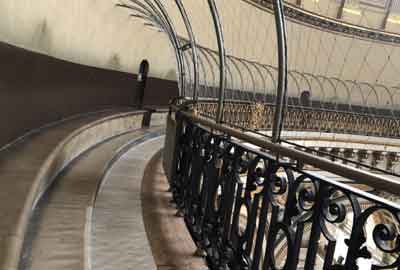
The Whispering Gallery
Renowned for its unique acoustic properties, it’s a fascinating experience not to be missed.
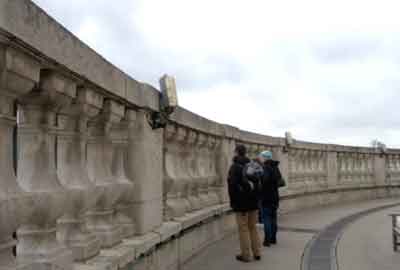
The Dome Climb
Take the journey to the Stone and Golden Galleries for unparalleled views of London.
The Stone Gallery image courtesy of stpauls.co.uk
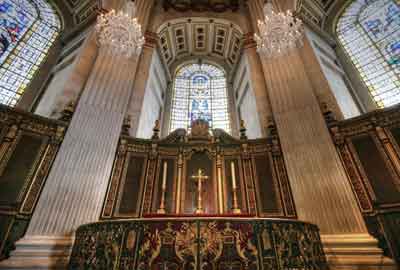
The High Altar
A masterpiece of craftsmanship and a focal point of the cathedral’s interior.
Image courtesy of stpaulstrust.org
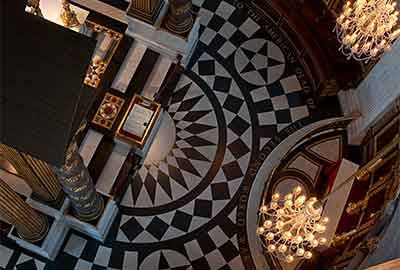
The American Memorial Chapel
Image courtesy of stpaulstrust.org
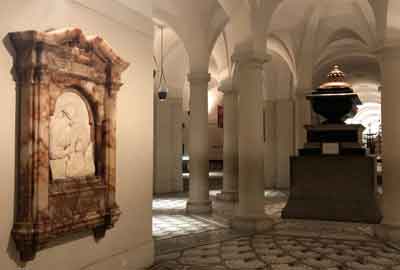
The Crypt
Resting place of famous figures like Sir Christopher Wren, Lord Nelson, and the Duke of Wellington.
Image courtesy of stpauls.co.uk
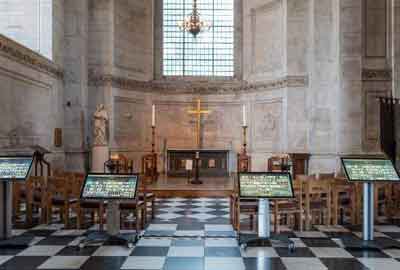
Remember Me Memorial
Situated in the Middlesex Chapel, a memorial to those who died as a result of the COVID-19 pandemic in the UK.
St. Paul’s Cathedral Geometric Staircase – Harry Potter Filming Location
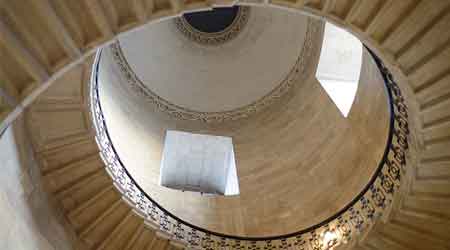
Image © Wiki Commons
Did you know this spiral staircase at St. Paul’s Cathedral was used as the Divination Stairwell in Hogwarts for students traveling to their Divination class?
Filmed on location, this iconic staircase is a must-see for any Harry Potter fan.
Discover more magical sites on our Harry Potter London Locations page.
Who Were Sir Christopher Wren, Lord Nelson, and the Duke of Wellington?
- Sir Christopher Wren was the acclaimed architect behind St. Paul’s Cathedral and many other significant buildings in London.
- Lord Nelson, Vice Admiral Horatio Nelson, was a British naval hero celebrated for his victories during the Napoleonic Wars, most notably at the Battle of Trafalgar.
- The Duke of Wellington, Arthur Wellesley, was a British military leader who defeated Napoleon at the Battle of Waterloo and later served as Prime Minister.
Map Diagram of St Paul's Cathedral
Before embarking on your visit to St. Paul’s Cathedral, take a moment to familiarise yourself with its layout to enhance your experience and plan accordingly. Then, delve into the heart of the Cathedral, starting with the bustling Cathedral floor, home to daily services and towering monuments such as Wellington’s dedication. Explore the solemn Crypt, where historical figures rest, and immerse yourself in the tranquil OBE Chapel and exhibitions. Gaze upward to admire the iconic Dome, a pinnacle of London’s skyline, and ascend the Whispering Gallery and external Galleries for breathtaking views. Complete your journey with a visit to the Cathedral shop for souvenirs and literature. Please note that access to the Galleries is via stairs only.
Cathedral Floor
The vibrant Cathedral Floor is where daily services occur and renowned monuments stand, such as Wellington’s dedication and St. Paul’s first monument, John Howard’s statue, with opportunities to engage with expert guides or embark on a self-guided multimedia tour.
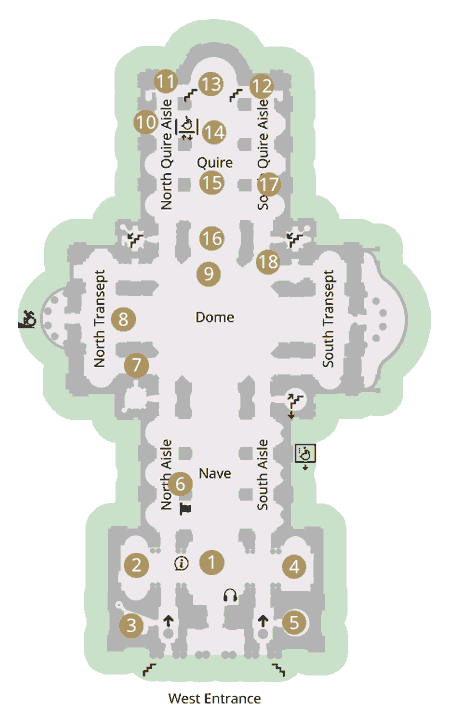
- The Font: Holds the water for Baptism ceremonies
- St. Dunstan’s Chapel: Consecrated in 1699 by Wren, it’s open all day for prayer.
- All Souls’ Chapel: Honors Lord Kitchener, known for his WWI army reforms.
- Chapel of St Michael and St George: Originally built as a consistory court for ecclesiastical law, now a chapel dedicated to St Michael and St George.
- The Geometric Staircase: Tucked within the south-west bell tower, steps seemingly ascend to the ceiling unsupported. Featured in Harry Potter films as the way up to divination class.
- The Wellington Monument: Honouring Duke of Wellington, a distinguished British soldier & statesman.
- Highlights from the textile collection: An exquisite embroidered textile dating back to around 1897, originally crafted to adorn an altar, featuring depictions of St. Peter, Christ, and St. Paul.
- The Middlesex Chapel: Also called the Chapel of St. Erkenwald and St. Ethelburga, a space for prayerand remembrance, with an emphasis on honouring those lost to COVID-19, part of Remember Me project.
- The Dome Altar: Where the daily Eucharist is celebrated, serving as the central focus of worship.
- “Mother and Child:hood” by Henry Moore: Marking the Cathedral’s first foray into contemporary art.
- “Mary” by Bill Viola: One of the two video installations on loan from Tate Modern showcasing scenes from the life of the Mother of Christ.
- “Martyrs” by Bill Viola: The second video piece depicting four individuals undergoing martyrdom by the classical elements: earth, air, fire, and water.
- The American Memorial Chapel: Restored after the Blitz, honouring 20,000 Americans who died in the UK during WWII.
- The High Altar: Marble and carved oak, adorned with a magnificent canopy inspired by Wren’s design.
- The Quire: Hosts the choir and clergy during services, adorned with carvings by Grinling Gibbons.
- The Grand Organ: Features a stunning case crafted by Grinling Gibbons.
- Effigy of John Donne by Nicholas Stone: A testament to the Dean of St Paul’s from 1621.
- John Howard’s monument by John Bacon the Elder: First monument installed in St. Paul’s, honouring the prison reformer who campaigned for change.
The Crypt
The Crypt at St. Paul’s Cathedral houses notable historical figures like Sir Christopher Wren and features the OBE Chapel and exhibitions. Visit the Cathedral shop for a variety of souvenirs, historical literature, and books on faith and worship.
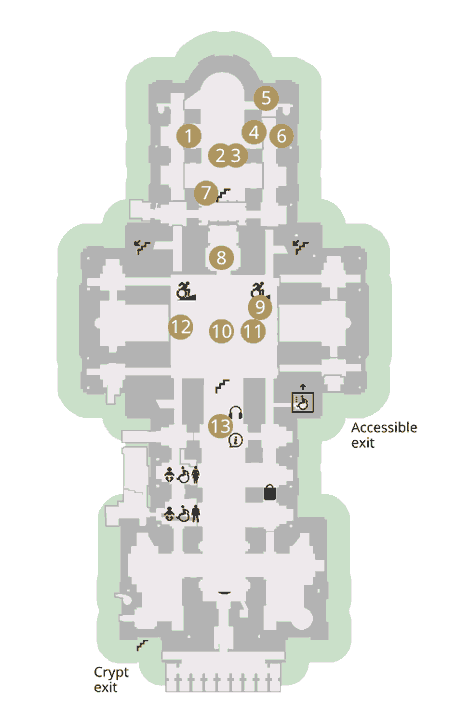
- Musician’s Memorials: Honouring renowned musicians, including composers Hubert Parry, Sir Arthur Sullivan, and Ivor Novello, alongside former organists and choir masters.
- The OBE Chapel: After the original parish church was lost in the Great Fire, it was transitioned to the spiritual headquarters of the Order of the British Empire (OBE), honouring civilian contributions in WWI.
- Artists’ Memorials: Numerous renowned artists and sculptors buried in close proximity. Also honouring those buried elsewhere or whose tombs were lost in the Great Fire.
- William Blake’s Memorial: Renowned for his talents as an artist, poet, printmaker, mystic, and radical activist, Blake was ahead of his time, often underappreciated in his lifetime.
- The Knights Bachelor Chapel: Also referred to as St. Martin’s Chapel, showcases the listings in elegant cases, and Queen Victoria’s sword used for knighting.
- Sir Christopher Wren’s Tomb: The renowned architect of St Paul’s Cathedral
- Scientists’ Memorials: Including Sir Henry Wellcome, Alexander Fleming, who discovered penicillin, and Gordon Hamilton-Fairley, the first medical oncology professor.
- Wellington’s Tomb: Crafted from Cornish granite, commemorates the Iron Duke, famous for his leadership and campaigns, adorned with banners from his funeral procession.
- The Falklands Memorial: Commemorates the 255 British lives lost in the Falklands War.
- Lord Nelson’s Tomb: Honours Lord Nelson killed in the Battle of Trafalgar in 1805. Crafted from the timber of a French ship he defeated, features a black marble sarcophagus.
- Florence Nightingale Memorial: Commemorated as the founder of modern nursing, with a marble memorial for her pioneering efforts and contributions to the profession.
- Exhibition Space: Showcasing archive material and objects from the Cathedral Collections, highlighting grand ceremonial occasions of four British monarchs.
- Winston Churchill Memorial Gates: Commemorating his state funeral held at St Paul’s.
The Dome
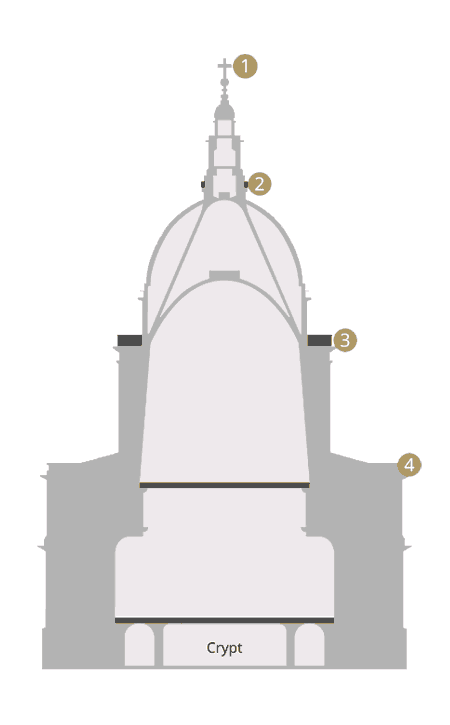
The Dome at St. Paul’s Cathedral, standing at 111 meters (365 feet), is a renowned London landmark designed to inspire awe. It features the unique Whispering Gallery inside and the Stone and Golden Galleries outside, offering breathtaking views. Access to the Galleries is via stairs only.
- The Ball and Lantern: Installed in 1821 by C. R. Cockerell, replaced the original structures from 1708, standing at 23 feet high and weighing around seven tonnes.
- The Golden Gallery: Located at the highest point of the outer Dome, 85 meters above ground level, the Golden Gallery offers stunning panoramic views of London to visitors who ascend its 528 steps.
- The Stone Gallery: Situated above the Whispering Gallery, the Stone Gallery is the lower of two galleries encircling the Dome’s exterior. Positioned 52 meters above ground level, it requires climbing 376 steps to reach.
- The Whispering Gallery: Ascend 257 steps from the Cathedral floor to reach the Whispering Gallery, encircling the interior of the Dome. Its unique construction allows whispers against its walls to be heard on the opposite side, giving it its name.
Map diagrams courtesy of St Paul’s Cathedral.
Explore the interactive map on the official website.
Climbing to the Top: The Dome Experience
Ascending to the heights of St. Paul’s Cathedral offers more than just a physical challenge; it’s a journey through the architectural splendour of Wren’s masterpiece.
What to Expect
- Whispering Gallery: Just 257 steps from the cathedral floor, this gallery is famous for its unique acoustics. It’s a place where a whispered word against its walls can be heard clearly on the opposite side.
- Stone and Golden Galleries: Continue climbing, and you’ll reach the Stone Gallery and then the Golden Gallery, the highest point of the outer dome, offering panoramic views of London that are nothing short of spectacular.
The effort to reach the top is rewarded with breathtaking views over the city, providing unparalleled photographic opportunities and a fresh perspective on London’s sprawling landscape.
What Are Some Lesser-Known Spots in St. Paul’s Cathedral?
- The Quire: Tucked away from the main tourist path, the Quire is a serene space with beautifully detailed woodwork, where the cathedral choir sings during services.
- The Chapter House: A quiet corner of the cathedral that houses unique artifacts and exhibits, often overlooked by visitors.
- The South Transept Door: Also known as the Dean’s Door, this is an intricately carved entrance not usually frequented by tourists but rich in detail and history.
- The Chapel of St. Michael and St. George: This chapel, often missed, contains memorials to military personnel and offers a peaceful spot for reflection.
- The Geometric Staircase: Featured in films, this architectural wonder is hidden in plain sight and leads to the library and archives, showcasing the brilliance of Wren’s design.
Lights, Camera, Action: Famous Films Featuring St. Paul's Cathedral
St. Paul’s Cathedral isn’t just a monumental piece of history; it’s also a star of the silver screen! Here are some of the famous films that have showcased this iconic London landmark:
- “Mary Poppins” (1964): Who can forget the touching scene with the song “Feed the Birds,” framing the cathedral’s steps as a place of kindness and warmth?
- “Harry Potter and the Prisoner of Azkaban” (2004): The cathedral’s Geometric Staircase starred as part of the magical world, creating an enchanting pathway in Hogwarts.
- “Sherlock Holmes” (2009): St. Paul’s distinctive architecture provided a dramatic backdrop for Sherlock’s adventures in this action-packed film.
- “London Has Fallen” (2016): Featuring in a high-octane action sequence, St. Paul’s proved it could hold its own amidst thrilling cinematic moments.
Accessibility at St Paul's Cathedral
Disabled visitors can fully enjoy their visit to the Cathedral with specially designed guides, tours, and improved physical accessibility measures in place. Complimentary tickets are offered to all disabled visitors, along with an accompanying carer or assistant, for sightseeing purposes. Worship at the Cathedral is always free for all visitors. The Visitor Experience team is ready to provide a warm welcome and assistance as needed during the visit, and Cathedral wheelchairs are available upon request.
St. Paul’s Cathedral in London provides accessibility through the new North Transept entrance, which features ramped access ideal for wheelchair users and those needing step-free access. The entrance grants direct access to the Cathedral floor. Wheelchairs are available upon request, and smaller mobility scooters are permitted inside. However, it’s recommended to verify if your scooter fits the lift dimensions (1,400mm length x 1,300mm width) connecting the Cathedral floor and Crypt, as larger scooters may not be accommodated.
The cathedral offers step-free access to the Crypt and Quire, accessible by lift and electric stair lift respectively. However, access to the galleries, including the Whispering Gallery, Stone Gallery, and Golden Gallery, is only via stairs. Visitors with mobility difficulties or concerns with heights are advised against climbing these stairs. The Triforium, available by advance booking, also lacks lift access, requiring climbing 141 steps and additional short flights of stairs during the tour route.
There are no parking facilities available at St. Paul’s Cathedral. However, Blue Badge holders can find on-street parking bays nearby. Additionally, Baynard House multi-storey car park, which offers disabled parking spaces, is conveniently located just a 5-minute walk from the cathedral. For more options, JustPark offers a range of disabled parking options conveniently located near St. Paul’s Cathedral. The service is free to use and assists in connecting drivers with available parking spaces via its website and mobile application.
The Cathedral offers audio description guides, encouraging tactile exploration of sculptures and carvings. Pre-booked “touch tours” are also available. Large print and Braille copies of service orders can be obtained from Visitor Experience Assistants.
Guide dogs, hearing dogs, and assistance dogs are all warmly welcomed inside St. Paul’s Cathedral. Visitor Experience Assistants will be happy to provide water for dogs.
Recognising the essential role of service animals, they are allowed on the London Eye. However, it’s always a good practice to inform the staff in advance for a seamless experience.
Wheelchair-accessible unisex toilets are available in the Crypt, catering to both left and right-handed users. Additionally, male and female toilets each feature a cubicle equipped with grab rails for ambulant users.
During sightseeing hours at St. Paul’s Cathedral, disabled visitors and their carers can request free tickets, which can be booked in advance or obtained on arrival. Worship at St. Paul’s Cathedral is always free.
Accessibility Map
You can download the accessibility map from St. Paul’s Cathedral’s official website.
History
St. Paul’s Cathedral has a rich history, echoing that of London itself.
It was built from 1675 to 1710, rising after the Great Fire of London.
This iconic structure is the work of the famous architect, Sir Christopher Wren. Imagine the resilience of Londoners back then. They envisioned a new cathedral from the fire’s ashes. It was to stand tall, a symbol of rebirth, shaping the city’s skyline.
I remember chatting with a guide on my first visit, who shared tales of resilience and hope that seemed to echo off the walls. St. Paul’s has seen its fair share of history – from jubilant celebrations to somber memorials, each event leaving an indelible mark on its soul.
Architecture of St Paul’s Cathedral
St. Paul’s showcases the stunning English Baroque. This iconic structure is the work of the famous architect, Sir Christopher Wren.
Its facade features two towers and a striking dome, known globally. Inside, its vastness amazes. You’ll find detailed mosaics, elaborate stone carvings, and shimmering gold leaf.
The dome itself is an architectural feat, one of the largest in the world. Climbing to the Whispering Gallery, I was struck by the peculiar acoustics; a whisper against its walls can be clearly heard on the opposite side. It’s a physical reminder of how even the softest voices can carry in unexpected ways.
And then there’s the view from the Golden Gallery. Trust me, the climb is worth every step. You’re rewarded with a panoramic view of London that is simply unrivalled. It’s a place where the past, present, and future of the city blend into one breathtaking vista.
Spiritual and Ceremonial Centre
St. Paul’s Cathedral isn’t just an architectural masterpiece; it’s the spiritual heart of London, playing a pivotal role in the Church of England and the nation’s life. Let’s delve into the essence of its spiritual and ceremonial significance.
The Role of St. Paul’s Cathedral in the Church of England
As one of the most iconic religious buildings in the UK, St. Paul’s serves as a vital centre for worship and spiritual growth within the Church of England. It’s the Bishop of London’s seat, making it a focal point for significant religious events and ceremonies. The cathedral has been a beacon of faith and hope, offering solace and inspiration to countless visitors and worshippers alike.
Major Ceremonies and Events
St. Paul’s Cathedral has hosted some of the most significant events in British history. Royal occasions, such as jubilees, weddings, and funerals, have seen the cathedral’s steps crowded with well-wishers and its aisles filled with pomp and pageantry.
- Notably, it was the setting for the fairy-tale wedding of Prince Charles and Lady Diana Spencer in 1981, an event watched by millions around the world.
- The funerals of Lord Nelson, Winston Churchill, and Margaret Thatcher, among others, were monumental, reflecting the cathedral’s central role in the nation’s collective heart and history.
Ongoing Religious Services and How Visitors Can Participate or Observe
St. Paul’s Cathedral is a living, breathing place of worship, with daily services that invite participation or quiet observation from visitors.
These include morning prayers, Eucharist services, and evensong, offering moments of reflection, peace, and spiritual connection. The cathedral’s choir is renowned worldwide, and their performances during services and special events are not to be missed.
Visitors are welcome to join these services, experiencing the cathedral not just as tourists, but as part of a communal act of faith and worship.
The cathedral also hosts special services throughout the Christian calendar, including Advent, Christmas, Lent, and Easter, each marked with solemnity and celebration.
A Personal Reflection
Stepping into St. Paul’s for a service, one can’t help but feel a part of something greater than oneself. The beauty of the liturgy, combined with the awe-inspiring surroundings, creates an atmosphere that’s both uplifting and grounding. It’s a reminder that, amidst the hustle and bustle of city life, there are moments of profound peace and spiritual richness waiting to be experienced.
Around St. Paul's Cathedral: Neighbourhood Guide
The area surrounding St. Paul’s Cathedral brims with attractions, dining, and shopping opportunities, making it a vibrant hub for visitors.
Nearby Attractions
- The Millennium Bridge, a striking pedestrian bridge leading to Tate Modern.
- The Museum of London, detailing the city’s rich history.
- The Barbican Centre, a cultural venue hosting concerts, exhibitions, and film screenings.
Dining and Shopping
- Paternoster Square offers a selection of dining options with stunning views of the cathedral.
- For shopping, head to One New Change, a modern complex with shops, restaurants, and a rooftop terrace offering views of St. Paul’s.
Frequently Asked Questions (FAQ) for St. Paul's Cathedral
Can I take photos inside St. Paul's Cathedral?
Photography is not permitted inside the cathedral to preserve the sacred atmosphere and ensure a peaceful experience for all visitors. However, photography is allowed on the external galleries, offering breathtaking views of London.
Are there guided tours available?
Yes, St. Paul’s Cathedral offers guided tours and self-guided audio tours. The guided tours provide in-depth insights into the cathedral’s history, architecture, and significant events, led by knowledgeable guides.
Is St. Paul's Cathedral accessible for visitors with disabilities?
The cathedral is committed to accessibility, offering ramps, lifts, and accessible toilets. Special arrangements can be made for visitors who require additional assistance. Please check the official website or contact the cathedral before your visit for specific details.
Can I attend a service at St. Paul's Cathedral?
Visitors are welcome to attend any of the daily services at St. Paul’s Cathedral. Attending a service is free of charge and does not require a ticket. It’s a wonderful opportunity to experience the spiritual life of the cathedral.
What denomination is St. Paul's Cathedral?
St. Paul’s Cathedral is an Anglican cathedral. Anglicanism is a branch of Christianity that originated in England during the Reformation in the 16th century. It is characterised by its adherence to the teachings of the Church of England, which was established by King Henry VIII after his split from the Roman Catholic Church. It emphasises scripture, tradition, and reason, and uses liturgical elements like the Book of Common Prayer. It’s a global tradition with millions of followers worldwide.
What should I wear when visiting St. Paul's Cathedral?
While there is no strict dress code for sightseeing, visitors are encouraged to dress respectfully, especially if planning to attend a service. Comfortable shoes are recommended due to the amount of walking and stair climbing involved in a visit.
How long should I allocate for a visit to St. Paul's Cathedral?
A typical visit to St. Paul’s Cathedral can last between 1.5 to 3 hours. This allows time to explore the main floor, crypt, and climb to the galleries, as well as possibly joining a guided tour or attending a service.
Are there dining options inside or near St. Paul's Cathedral?
While there are no dining facilities inside the cathedral, the surrounding area offers a variety of dining options. From cafes and fast food to fine dining, visitors will find something to suit all tastes and budgets.
Is there a gift shop at St. Paul's Cathedral?
Yes, St. Paul’s Cathedral has a gift shop where visitors can purchase souvenirs, books, and items related to the cathedral and its history. Proceeds from the shop support the maintenance and operation of St. Paul’s.
Can I visit St. Paul's Cathedral for free?
Entrance to St. Paul’s Cathedral requires a ticket for sightseeing. However, entrance is free for those attending services, offering a chance to experience the cathedral’s spiritual life without the cost.
What is the best time to visit St. Paul's Cathedral to avoid crowds?
Weekday mornings soon after opening are typically the quietest times to visit. It’s also advisable to check the cathedral’s calendar for any special events or services that might affect visitor numbers.

